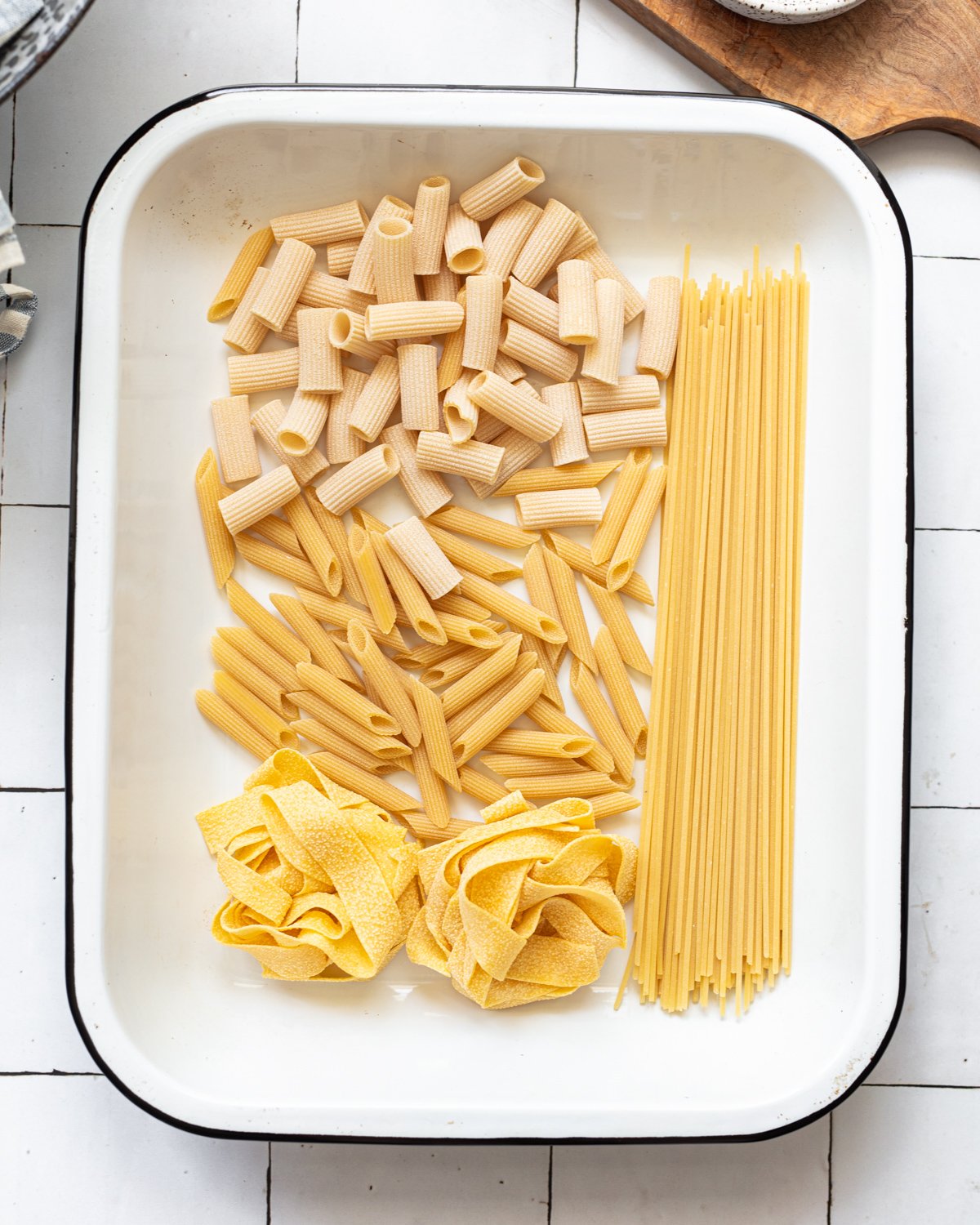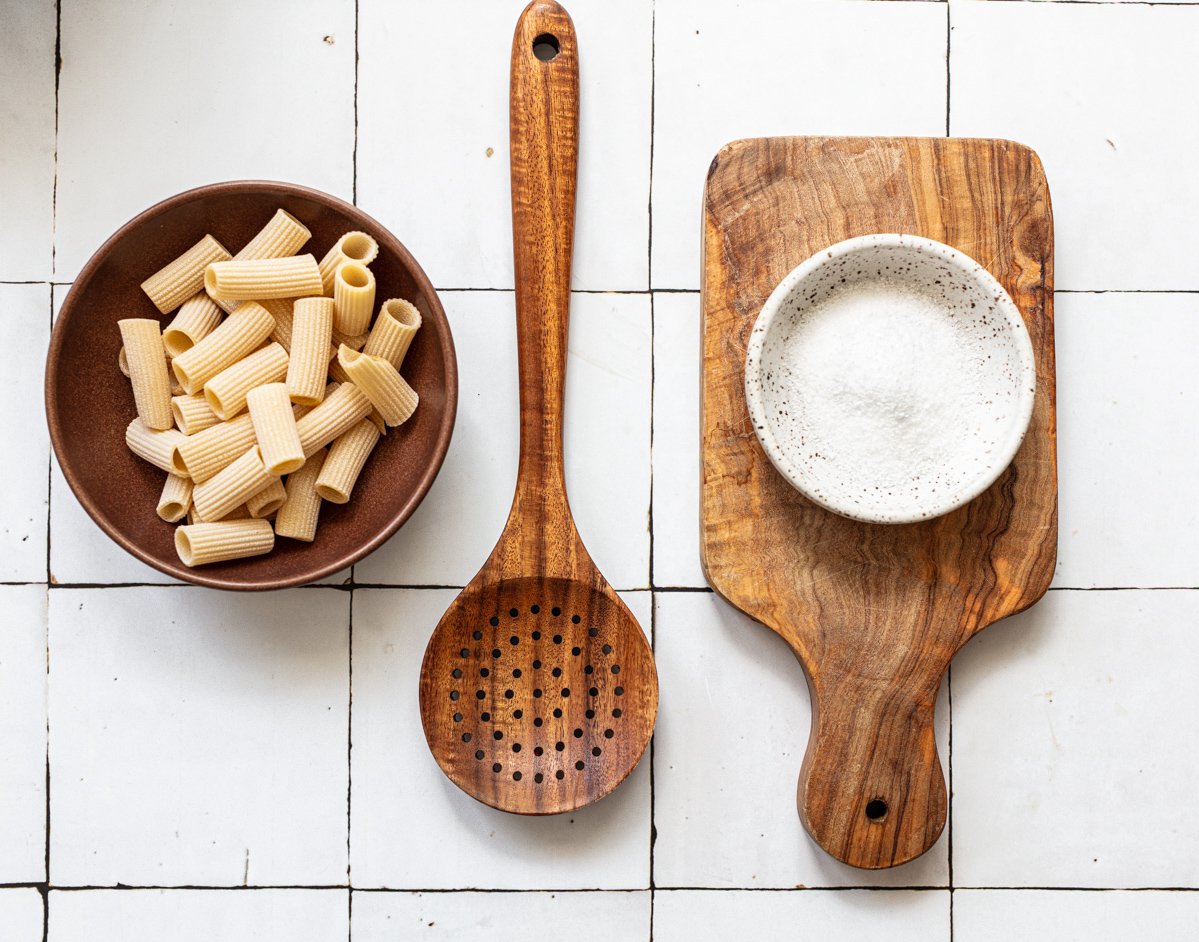Fresh versus dried pasta
This tutorial explains how to cook dried, extruded pasta, as well as short or long pasta shapes made with water and durum wheat flour. In contrast, fresh pasta requires different cooking methods and is made with eggs.

Tip: Buy high-quality dried pasta. Pasta that has been cut with bronze dies has a wonderful rough texture, which is the BEST for catching sauce. Good pasta in hand, you’re already halfway to making the best pasta ever.
Frequently asked pasta-cooking questions:
Learn the three “golden rules” and become an expert pasta cook:
- Water volume: Find out how much water to use when preparing pasta.
- Salt quantity: The best salt ratio for tasty pasta
- Cooking time: Time chart for different pasta shapes
#3: Pasta Cooking Time
To boil pasta, add four to five quarts of water to a large pot and bring it to a rolling boil. Add the pasta and 1 tablespoon of salt to each quart of water. Stir frequently, and taste the pasta at intervals.
- There is no one-size-fits-all pasta; different pasta shapes and brands will require different cooking times. What you’re going for is that all-important al dente texture.
- The cooking instructions on the box might not always be accurate, so I urge you to use your senses rather than just setting a timer and leaving. Taste early (about 3 minutes into cooking time) and often.
For a general idea of pasta cooking times, consult this chart of popular pasta types:
Time starting with adding pasta to boiling salted water. Refer to package directions and be sure to taste-test!.
- Spaghetti + Linguine: 8-10 minutes
- Bucatini: 10-12 minutes
- Angel Hair + Capellini: 4-6 minutes
- Penne + Ziti: 6-8 minutes
- Farfalle (Bowties) + Shells: 8-10 minutes
- Rigatoni: 11-13 minutes
- Orecchiette: 12-15 minutes
- Fusilli + Rotini Noodles: 8-10 minutes
- Pappardelle + Fettuccine: 6-8 minutes
- Cook the pasta as directed if using it in a cold pasta salad. After draining and tossing with enough olive oil to coat, spread the mixture onto a baking dish or sheet pan and let cool, stirring from time to time to prevent it from sticking together. Transfer to a container, add the salad dressing and refrigerate.
- When preparing food for a gathering or dinner party, prepare your sauce ahead of time and cook the pasta right before serving. Hot pasta waits for no one!.
- Don’t rinse cooked pasta. It is not wise to throw away all that valuable starch that “marries” the pasta to the sauce.
- Is adding oil to boiling pasta necessary to keep it from becoming sticky? No, please! Oil forms a smooth layer that keeps sauce from adhering to the pasta’s surface. If anything it’s a waste of good olive oil. Just use enough boiling water as directed and stir, stir.
The pasta known as al dente, which translates as “to the tooth,” has a bouncy texture when you bite into it. When you crack open a perfectly cooked pasta piece, a lighter yellow core should be visible.
To attain the elusive al dente doneness, one must taste the pasta while it is cooking. Pasta will continue to cook after you drain it and add your homemade tomato sauce, amatriciana sauce, or a spicier version of arrabbiata sauce, so practice undercooking it a little.
When I’m multitasking in the kitchen, I usually turn off the heat a minute or two before the pasta is done, letting it finish cooking in the hot water.
